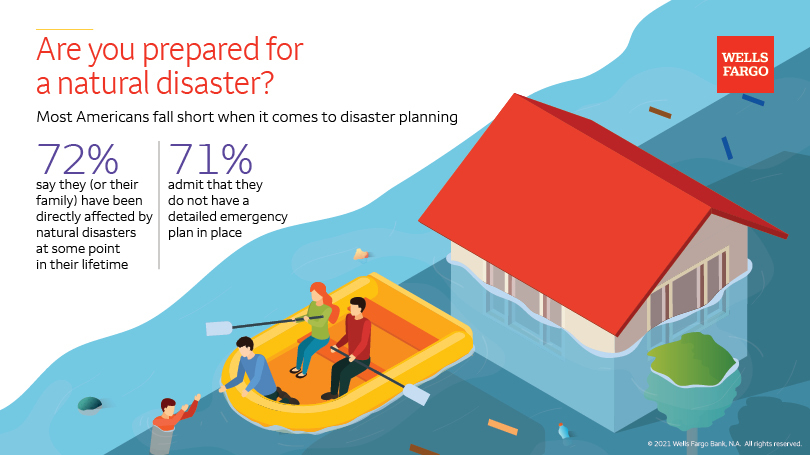 Whether it’s heat or blistering cold, tornados or derechos, earthquakes or wildfires, hurricanes or floods, natural disasters have affected 84% of Americans in the last three years, but the large majority of Americans are not prepared for future disasters, whatever they may bring.
Whether it’s heat or blistering cold, tornados or derechos, earthquakes or wildfires, hurricanes or floods, natural disasters have affected 84% of Americans in the last three years, but the large majority of Americans are not prepared for future disasters, whatever they may bring.
According to a new Wells Fargo & Company survey [1], four in five Americans (84%) live in areas that have experienced some form of natural disaster in the past three years, and more than half (54%) live in areas that have experienced severe natural disasters, specifically hurricanes, tornadoes, floods, wildfires, or earthquakes. Furthermore, nearly three-quarters of respondents (72%) say they or their families have been directly impacted by natural disasters at some point in their lifetime.
“The survey affirms a lack of physical preparedness as well as financial readiness for emergencies for most people,” said Rullah Price [2], Head of Public Affairs of Resiliency & Enterprise Incident Communications for Wells Fargo. “Given that half of those surveyed said they would like their bank to proactively help them plan for a natural disaster, I believe there’s an opportunity for Wells Fargo to educate and inspire people to make some changes for the better—starting now.”

According to the survey, 40% of respondents stated that described themselves as “barely covered” and only had an idea of their plans in the event of an emergency. 39% said they had adequate plans in place, and 5% described themselves as a “super planner” and were ready for every emergency.
However, the survey shockingly showed that 16% of respondents had avoided thoughts or preparations altogether, leaving them completely unprepared.
The survey also found that those who do have an emergency plan (29% of Americans) prioritize having food and water supplies (78%), emergency cash (63%), access to important documents (61%), and a planned transportation/evacuation route (59%).
Items of slightly lower priority include a plan for their medical needs (54%), family communication plan (52%), shelter plan (49%), or plan for their pets (44%).
“Most people’s plans are lacking in detail. It’s necessary to really think through all the possible scenarios. For example, only a quarter of respondents have outlined specific plans for members in the household of different ages. This is incredibly important for vulnerable ones like children and seniors,” added Price.
People should not just be physically prepared for a disaster, but financially too. The study found that only 44% have an emergency savings account and 39% said they have no emergency cash on hand to use to buy supplies, lodging, or get out of an area quickly in case electronic payments methods are not available.
Additional findings on preparedness:
- 32% of respondents have a go-bag packed in case of natural disaster.
- 43% do not keep their gas tanks filled halfway for emergency evacuation.
- 46% have an emergency kit that includes supplies that will last for several days after a disaster for everyone living in their home.
- 54% have a two-week emergency food supply in their home.
- 38% report that their important documents are not easy to find in their house.
- 31% have documented possessions by taking photos and videos of their house and household items in case they need to make an insurance claim.

Data for this research was collected for Wells Fargo & Company by Ipsos [3], an insights and analytics company, over a four-day period in September and had a total of 2,226 respondents.